Hurricane Matthew made landfall in the Carolinas this morning, just north of Charleston, SC, and more than 5" of rainfall is expected for the Raleigh region over the next 24 hours. With the cool, windy and very wet weather keeping most of the Mid-Atlantic seaboard indoors until late Sunday it was time to get cooking.As part of this week's CSA delivery from The Produce Box I special ordered 15 lbs of slightly blemished Ginger Gold Apples from a local farmer to make applesauce in my pressure cooker.Apples were peeled (not guaranteed organic), cored and cut into 16ths. Some very small bruises were present and easily cut out.The apple chunks and spices were placed in the pressure cooker - I used Flo Lum's recipe with two variations, I added a bit of freshly ground nutmeg and cut my apple chunks a bit smaller for a smoother texture.The end result was a delicious treat that will not last long enough to worry about freezing.I know apples are traditionally paired with pork, but try pairing them with homemade cheese quesadillas, especially for the under 10 yo set!
Read More10% Campaign and Starfish
In 2010, the Center for Environmental Farming Systems (CEFS) teamed up with the NC Cooperative Extension at North Carolina A&T State University and the North Carolina State University to launch the NC 10% Campaign to encourage individuals and businesses to make locally grown, caught and produced foods 10% of their food budget. Over $35B is spent on food annually by North Carolinians meaning a whopping $3.5B would stay in state to support local farmers, fishermen and food producers if the campaign was adopted universally.North Carolina has an embarrassment of food producing resources in the form of abundant sunshine, rainfall, land and coastal waters for seafood. The campaign produced this wonderful seasonality chart that highlights just how bountiful our state is. Designating 10% of food dollars to stay in state and supporting our local food producers couldn't be easier or more delicious! For North Carolinians, eating seasonally means eating fresher more nutritious food, enjoying a greater variety in our diets and eating locally means reducing the carbon footprint of each meal in terms of the energy needed to transport temperature controlled food long distances across the country or globe.The 10% goal may seem to be a rather low bar for those that already support local food producers with a significant percentage of their food dollars, but it is the low threshold that makes it possible to be accepted and adopted by a larger proportion of North Carolinians thereby making a bigger difference in the lives of our food producers, our state economy, the sustainability of our food system.Thinking about this challenge reminded me of the Starfish Story*A man was walking along a beach and as he walked he could see a young boy in the distance. The boy kept bending down, picking something up and throwing it into the water. As the man drew closer he saw that the boy was picking up starfish that had been washed up on the beach and was throwing them back into the water. The man asked the boy what he was doing, and the boy replied, "I am throwing these washed up starfish back into the ocean, or else they will die." "But you can't possibly save them all, there are thousands on this beach, and this must be happening on hundreds of beaches along the coast. You can't possibly make a difference.", said the man. The boy smiled, bent down and picked up another starfish, and as he threw it back into the sea, he replied, "I made a difference to that one."If you want to make a difference too, visit the NC 10% Campaign Partners Page to find restaurants, grocery stores, you pick farms and farmers working with the program to make North Carolina an even better place to eat.*The Starfish Story has made the rounds over the decades and been adapted many times.
Read MoreFill the Freezer
With only 7 Saturdays left before the end of the shopping season, the Apex Farmer's Market shopping season I mean, it is time to start asking my favorite protein farmers about bulk purchases before the end of season and off season sales at their farms.Carolina Catch Seafood - Seafood, part of a coastal catcher's cooperative, possible off season sales at a location in Holly SpringsHeston Farms - Beef, family farmers, will do off season sales either at their farm in Roxboro, NC or possibly meeting in Durham so it is still a good idea to stock upLittle River Eco Farm - Pork (they also sell chicken, eggs, beef, turkeys), off season sales are unlikely so I will be placing a bulk order for the Mexican Chorizo and Sweet Italian Sausage that are mainstays in my kitchenOn a related note, the Apex Farmers Market is trying to go year round, possibly one market a month during the off season, but they need an enclosed winter location. Fingers crossed they can find something!
Read MoreA New Old Fashioned Barn Raising
I was researching a local farm that I am interested in purchasing from and ran across an article about their recent BarnRaiser.us campaign to improve the sustainability and profitability of their livelihood. I was intrigued and wanted to learn more about BarnRaiser.There are so many things to love about this artisanal food crowdfunding site:
- The name is wonderfully evocative of the end goal, a community coming together to support the needs of farmers and food artisans
- The admirable mission statement is "To put a billion dollars into the hands of food innovators as they reshape a healthy food world."
- BarnRaiser fees are based solely on fully funded goals. No goal = no fee for trying
- And like the other crowdfunding sites, the farmers and artisans looking to get funded offer up little goodies for supporting them at different levels
- Projects seeking funding are listed in a gallery format with name and photo, a status bar showing how much money has been pledged and how much money and how many days are left to fund the project and, last but not least, location for the project
- According to the FAQ, Project Creators are subject to some level of identity verification
- The site is great exposure for the farmers and food artisans whether they reach their funding goals or not
Let's go raise some barns!
To Buy or Not To Buy, That is the Question (Dal Fry)
Each year between September and January the question of "what to grow" must be asked and answered by growers everywhere. This is the time of year when seeds are carefully saved, seed catalogs are perused and garden plans begin to be sketched out for the following year.Asking and answering the question of what to grow necessarily means also answering the question of what not to grow, i.e. "what to buy" the following year with the answer being - everything else.Wendell Berry spoke eloquently on the consumer side of agriculture with his often cited quote, "Eaters must understand that eating takes place inescapably in the world, that it is inescapably an agricultural act, and that how we eat determines, to a considerable extent, how the world is used." So this answer to "what to buy" is in many ways, just as important as what we chose grow.Consumers are considering this question of the provenance of our food more often today and answering it from a variety of perspectives such as the locally-seasonally available movements to reduce food miles like the 100 Mile Diet (and its many variations), the Fair Trade movement and the certified organic movement. We are setting personal standards and restrictions on what we can and will purchase.Though it doesn't have a name or a label, another way to look at growing vs. purchasing locally from other growers vs. purchasing locally after being transported from across the globe is to consider the water content. Fruits and vegetables in particular have incredibly high water content and shipping this water across the world with fossil fuels comes at enormous environmental impact.Foods that are high in water content are highly perishable so the varieties grown are selected for their ability to withstand the journey, not for their flavor or nutrition. The perpetual summer these commercially grown and shipped varieties create in our grocery stores crowds out consumer demand for locally grown produce when it is in season, impacting the number of US family farmers that can make a living growing food.So which foods make a great planned buying list? Outside of locally grown fruits and vegetables, purchased from local farmers when they are in season, buying dried foods which are light and unlikely to be damaged in transport compared to high-water foods helps keep local farmers farming and reduces the need to ship water from one part of the globe to another. Rice, wheat, oats and other grains as well as beans, lentils and pasta are all high in nutrition, lightweight compared to water heavy fruits and vegetables, have a long shelf-life and the water gets added by you when you are ready to use them.A few months ago I wanted to try making a dal fry (a Punjabi lentil dish) and found this great crock pot recipe for toovar dal fry over at The Novice Housewife which I made with only one modification - I added the tomatoes at the end of cooking the dish, not the beginning.The dal fry was fantastic and I wanted to investigate growing lentils myself. I quickly learned that the lentils used in the dish cannot be grown in my humid area so were not a candidate for future garden plans, but since they are a dried and nutritious food as well as being delicious, dal fry will remain on my menu.
Farm Envy
I have farm envy.This is not anything new. My brakes frequently light up at red outbuildings, generous lots and dilapidated farmhouses. Farms with For Sale signs put me at risk for whiplash. Over the years I have learned to live with a certain level of farm envy and consider it my normal state of being. Then I watched The Fruit Hunters a couple of months ago and the desire for a couple acres ratcheted up a few notches immediately.Fruit trees take time to produce fruit, years in most cases. Berries too. My mind began to consider the idea of a couple of acres that I could start a little orchard with blue, black and raspberries on the land while I bide my time in the burbs between now and when I would be able to live on this imaginary farm full time.Then I visited Cozi Farms on a beautiful fall day yesterday and the farm envy reached an entirely new fervor.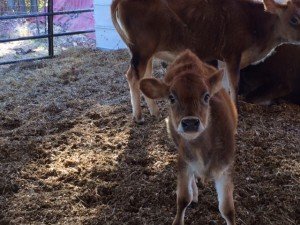
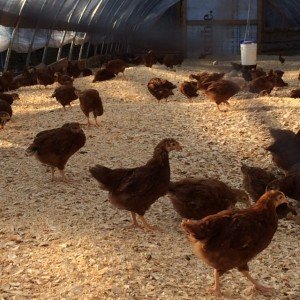
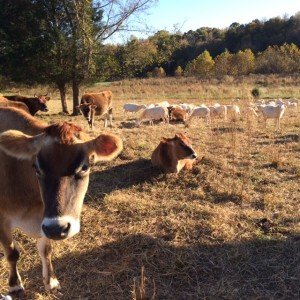 On over 60 beautiful, rolling acres, Suzanne is growing beef, milk, eggs, broilers, lamb and turkeys. It was inspiring both in aesthetics and what she is working toward - sustainable agriculture that improves rather than depletes the land it is on.While I don't want or need that many acres and have no interest (currently) in raising large meat animals, it nonetheless made me homesick for the little farm of my dreams...a few acres with chickens and maybe ducks, hopefully a small pond stocked with fish and plenty of raised bed gardens that I can grow most of what I need from while I watch the sun make it's yearly transit from high overhead to low in the southern sky each year.
On over 60 beautiful, rolling acres, Suzanne is growing beef, milk, eggs, broilers, lamb and turkeys. It was inspiring both in aesthetics and what she is working toward - sustainable agriculture that improves rather than depletes the land it is on.While I don't want or need that many acres and have no interest (currently) in raising large meat animals, it nonetheless made me homesick for the little farm of my dreams...a few acres with chickens and maybe ducks, hopefully a small pond stocked with fish and plenty of raised bed gardens that I can grow most of what I need from while I watch the sun make it's yearly transit from high overhead to low in the southern sky each year.
Winter Market
Today was the first of two Winter Markets for the Kansas Grown Farmer's Market. The market was held inside the extension building which was a bonus with winds today gusting up to 37mph.I visited with Indian Creek Bison Ranch, a farm that I had seen many times at the entrance to the market but never purchased from before. All the bison are grass-fed, antibiotic and steroid-free so I walked away with a pack of frozen bison burgers to try.I also visited with Morning Harvest Farm that specializes in pastured poultry, pastured eggs and grass-fed beef. Paula was wonderful to talk with and I learned that she shares my passion for Joel Salatin books. Her pastured poultry schooners look to be based on his egg-mobiles. I purchased a package of summer sausage and beef links and grabbed a brochure for her farm.After getting home and getting all the market goodies put away I spent some time with the Morning Harvest Farm brochure and am even more intrigued. They also offer herbs, vegetables and farm raised fish. They have a CSA (Consumer Supported Agriculture) program that runs year round and allows you to select the products you receive. According to the website all CSA shares for Morning Harvest Farms are sold and the waiting list is full. Based on their farm and products I am not surprised. I will be checking back regularly to see when they have an opening on the wait list.
Something Cooking At Nearly Home Grown
I have found myself thinking of the Ant and the Grasshopper over the past 2 months as I have busily worked to build up a full freezer's worth of frozen tomato paste, whole roasting chickens and chicken breasts, butternut squash, spinach and basil hoping that each will manage to retain a bit of the freshness and vitality of summer.Storing the bounty of this year and hoping it will tide me over until the first farmer's market of the spring has inevitably led to thoughts of what next year will bring to the table and freezer. After much thought, planning, reading four Michael Pollan books, one Barbara Kingsolver book and watching more videos from Patti Moreno than I can count, I have decided to start my own garden for 2012 to supplement the organics I purchase from the farmer's markets.I will be experimenting with the Square Foot Gardening method created by Mel Bartholomew with heirloom, open pollinated seeds from Baker Creek Heirloom Seeds and Seed Savers Exchange. I have already learned that there are more different vegetables and varieties of each than our meager yard can contain so I have had to use the cold eye of an executioner to whittle down the roar of 'wants' to a manageable list of 'needs'. Maybe next year will herald some truly home grown goodness here at Nearly Home Grown...In the meantime, I will keep updating with recipes from this year, planning for next year and anything related to local food that sparks an interest!
Winding Down
This weekend I got my first real sense that it was time for the Farmer's Markets to wind down for the year. I visited the Neosho Farms stand to pick up some onions and garlic and asked whether a special they were having on garlic would be available next weekend. The answer was "this is our last weekend for the year".I immediately headed over to Cheney Lake Tomatoes to talk to John about his tomatoes that are sold at Green Acres Market. I asked if there would be any gaps this winter and how often he delivered tomatoes to GAM. I have become attached to my homemade pasta sauce and am having a hard time imagining going back to the jarred stuff this winter. I have looked into canning but am not quite ready to take the plunge just yet.With the end of the season nearing, we will be at the market every Saturday between now and the official end trying to take in a little more of the locally grown, fresh produce and the last of the summer days.
Souped Up
In the middle of what seems like the longest heat wave in history, my 4 year old came down with a head cold. Last weekend I had noticed homemade egg noodles at the Phil's Family Farm booth at the KGFM, so this weekend I stopped by Phil's and picked up 2 8oz bags of the homemade narrow egg noodles.I have a family recipe for chicken noodle soup that calls for boiling a chicken until all that is left is tasteless muscle fiber and using the resulting broth for the soup base. I had also picked up a free range fryer from Phil's, but it seemed like such a waste so I opted to use organic chicken broth instead. I use Pacific Natural Foods low sodium, but any broth you use should be fine.Chicken Noodle Soup8 cups chicken broth3 organic carrots, peeled and thin sliced8 oz. egg noodlesSalt and pepper to taste.Bring broth and carrots to a boil then reduce heat to a simmer. Cook for 20-30 minutes or until carrots are cooked to desired tenderness. Add noodles and cook 7-10 minutes or until noodles are done. Salt and pepper to taste. Makes about 7 servings.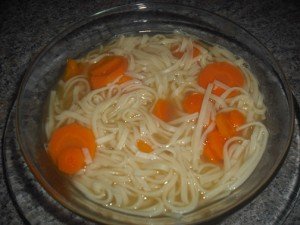
Mangia
I have been fine-tuning a pasta sauce recipe for a few weeks and I think it is as close to 'right' as it is going to get for now. So on Saturday I headed to the Kansas Grown Farmer's Market for fresh tomatoes, garlic and onion. I knew that Saturday was the big annual Tomato Day at the market so hopes were high until ...Cheney Lake Tomatoes had enough for my purposes, so I gathered my other items and headed over to the Old Town Farmer's Market.The Old Town market is more artsy than the Kansas Grown. There are more 'other' stands than fresh produce stands, but they have one that I have been going back to week after week - Pappardelle's by local vendor Pastalicious. I have tried 4 or 5 of their varieties but are currently hooked on the Pasta Luce. The other varieties have been wonderful, but when trying to get the sauce just right I didn't want the distraction of flavored pasta. Pasta Sauce Recipe 2.4.14 tomatoessplash of olive oil (about 2 TBS if you are a precise sort of person)2 cloves of garlic (or to taste)1 medium onion (or to taste)2 teaspoons sugar (I used organic cane sugar)1/2 tsp saltfew sprigs of fresh oregano (1/4 tsp dried or to taste)few sprigs of fresh rosemary (1/4 tsp dried or to taste)few springs of fresh basil (1/4 tsp dried or to taste)bottle of your favorite wineStart by blanching your tomatoes - bring a pot of water large enough to hold them to a boil and prepare an ice bath. While you are waiting for your water to boil, chop your onion (finely), rosemary and oregano. Mince your garlic. Pour a glass of wine and imagine you are cooking in a gourmet kitchen somewhere in Tuscany.Once the water is boiling, put your tomatoes in. If the skins split they are ready for the ice bath. Don't leave them in the boiling water longer than a minute, whether the skins have split or not. Leave in the ice bath for a couple of minutes to completely cool. Check on your wine - it may need to be topped off.Once cooled, core the tomatoes and remove skin. The skin should just peel right off. Chop tomatoes into 1 inch chunks and use either a hand blender or a food processor to blend to desired consistency.Put olive oil in a medium sized sauce pan on medium heat. Add garlic, rosemary, oregano and onion. Cook until the onions are soft and translucent. Add the tomatoes, sugar and salt - bring to a simmer. Simmer for approximately 20-30 minutes, to thicken the sauce. Chop basil and set aside.Get water going for your pasta and start approximately 10 minutes before you want to take your sauce off. When sauce and pasta are both done remove sauce from the heat and stir in basil while you drain pasta. Find your glass of wine and check temperature, bouquet and flavor.Enjoy!
Pasta Sauce Recipe 2.4.14 tomatoessplash of olive oil (about 2 TBS if you are a precise sort of person)2 cloves of garlic (or to taste)1 medium onion (or to taste)2 teaspoons sugar (I used organic cane sugar)1/2 tsp saltfew sprigs of fresh oregano (1/4 tsp dried or to taste)few sprigs of fresh rosemary (1/4 tsp dried or to taste)few springs of fresh basil (1/4 tsp dried or to taste)bottle of your favorite wineStart by blanching your tomatoes - bring a pot of water large enough to hold them to a boil and prepare an ice bath. While you are waiting for your water to boil, chop your onion (finely), rosemary and oregano. Mince your garlic. Pour a glass of wine and imagine you are cooking in a gourmet kitchen somewhere in Tuscany.Once the water is boiling, put your tomatoes in. If the skins split they are ready for the ice bath. Don't leave them in the boiling water longer than a minute, whether the skins have split or not. Leave in the ice bath for a couple of minutes to completely cool. Check on your wine - it may need to be topped off.Once cooled, core the tomatoes and remove skin. The skin should just peel right off. Chop tomatoes into 1 inch chunks and use either a hand blender or a food processor to blend to desired consistency.Put olive oil in a medium sized sauce pan on medium heat. Add garlic, rosemary, oregano and onion. Cook until the onions are soft and translucent. Add the tomatoes, sugar and salt - bring to a simmer. Simmer for approximately 20-30 minutes, to thicken the sauce. Chop basil and set aside.Get water going for your pasta and start approximately 10 minutes before you want to take your sauce off. When sauce and pasta are both done remove sauce from the heat and stir in basil while you drain pasta. Find your glass of wine and check temperature, bouquet and flavor.Enjoy!
Apple Butter and Tomato Jelly
Today I stopped by the Wild Family Farm stand to pick up a couple of pints of their homemade apple butter. My grandmother made apple butter like this and the taste whisks me back to the table in her small farm kitchen where I would watch her canning while I munched on a slice of bread slathered in her apple butter.The WFF stand has a good assortment of fresh herbs, decorative plants, jams and jellies. While I was there, I perused some of the other labels and saw one for Tomato Jelly. Apparently tomato jelly has a small, but devoted fan club that seek out this unusual delicacy wherever it can be found. I have never had it and my brain can't quite reconcile the idea of tomatoes and a jelly into a single item. But I was told it does have it's fans, so if you are near Wichita, KS and need a tomato jelly fix, now you know where to find it.
The Genesis Story
Two weeks ago I went to the Kansas Grown Farmers’ Market and came away with 7 organically grown Geronimo tomatoes (Cheney Lake Tomatoes) and 2 organically grown Genovese Compact, Improved Basil plants (Wild Family Farm).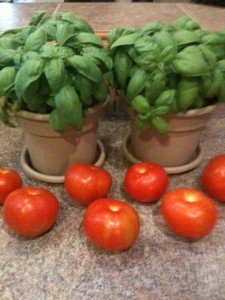 Saturday I went back for a dozen more tomatoes and a third basil plant. It’s official. I'm hooked.
Saturday I went back for a dozen more tomatoes and a third basil plant. It’s official. I'm hooked.
